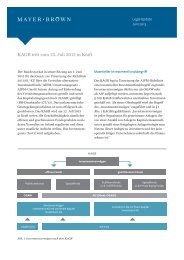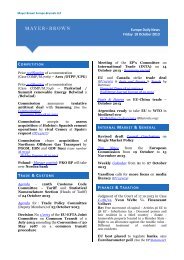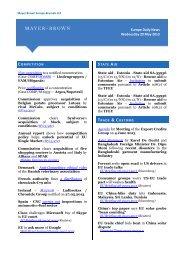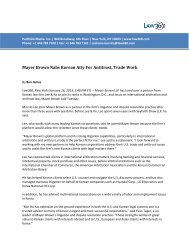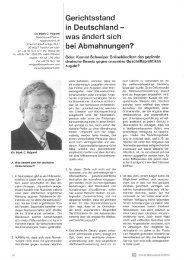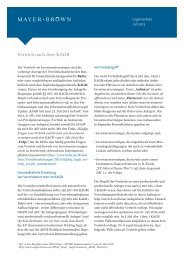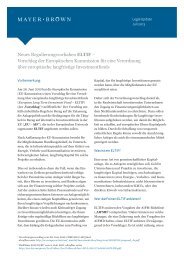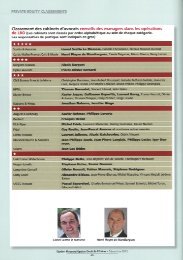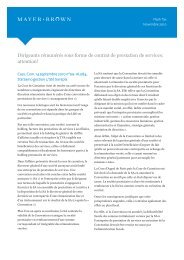Appleby Mayer Brown Insurance Presentation
Appleby Mayer Brown Insurance Presentation
Appleby Mayer Brown Insurance Presentation
You also want an ePaper? Increase the reach of your titles
YUMPU automatically turns print PDFs into web optimized ePapers that Google loves.
<strong>Insurance</strong> and Reinsurance Legal<br />
Developments: Financial Convergence<br />
& Global Regulatory Updates
The Convergence of Derivatives and<br />
<strong>Insurance</strong><br />
Ed Parker<br />
Partner<br />
Banking and Finance<br />
London
I. Transformer Structures<br />
A. Basic <strong>Insurance</strong> to Derivative Structure<br />
1 2 3<br />
Policyholders Insurer Reinsurer Counterparties<br />
<strong>Insurance</strong><br />
Policy<br />
Reinsurance<br />
Contract<br />
Swap<br />
Contract
I. Transformer Structures<br />
A. Basic <strong>Insurance</strong> to Derivative Structure<br />
Risk begins life as an insurance policy and ends up (in whole or in<br />
part) as a derivative. Examples Include:<br />
<strong>Insurance</strong> Policy (Front End) Derivative (Back End)<br />
• Variable annuity with rider benefit •Equity derivative<br />
•Fixed annuity, life contingent (incl. •Longevity swap; interest rate or<br />
pension)<br />
inflation hedge<br />
•Term life, accumulation of XXX<br />
reserves<br />
•Mortality swap<br />
•Financial guarantee policy •Credit default swap<br />
•Property insurance policy or portfolio •Weather derivative; cat swap<br />
•Other dual trigger property & casualty •Weather; commodities; currency;<br />
inflation
I. Transformer Structures<br />
A. Basic <strong>Insurance</strong> to Derivative Structure<br />
1 2 3<br />
Policyholders Insurer Reinsurer Counterparties<br />
<strong>Insurance</strong><br />
Policy<br />
Reinsurance<br />
Contract<br />
Swap<br />
Contract
Goals<br />
I. Transformer Structures<br />
A. Basic <strong>Insurance</strong> to Derivative Structure<br />
Goals of <strong>Insurance</strong>-to-Derivative Transactions<br />
• Insurer may seek alternative (to reinsurance) market for risk transfer capacity, or<br />
natural home of risk is swap market rather than traditional reinsurance. For life<br />
or property & casualty insurer, transformer structure provides access to<br />
derivative market for risk transfer while also providing:<br />
Credit Credit for reinsurance (netting down of reserves)<br />
Risk based capital relief (RBC is shifted to transformer entity)<br />
Hedge capacity without need for derivative use plan<br />
• Ultimate seller of protection may prefer derivative form.<br />
May not be licensed as insurer or reinsurer<br />
May be more comfortable with swap documentation, legal framework<br />
May prefer swap structure in connection with collateral arrangement<br />
• Preservation of accounting treatment.<br />
Accrual accounting<br />
Embedded derivatives
I. Transformer Structures<br />
A. Basic <strong>Insurance</strong> to Derivative Structure<br />
1 2 3<br />
Policyholders Insurer Reinsurer Counterparties<br />
<strong>Insurance</strong><br />
Policy<br />
Reinsurance<br />
Contract<br />
Swap<br />
Contract
I. Transformer Structures<br />
A. Basic <strong>Insurance</strong> to Derivative Structure<br />
Mechanics of <strong>Insurance</strong>-to-Derivative Risk Transformation<br />
1 Traditional insurer (domiciled in US) issues policy<br />
2<br />
3<br />
Reinsurer, as transformer entity, issues reinsurance contract<br />
to insurer<br />
• Domiciled offshore; alternative approaches, licensing status<br />
• Domiciled in jurisdiction (e.g., Bermuda) that allows back<br />
end derivative to provide capital treatment<br />
• Collateralizes with LOC, Reg 114 Trust or Funds Withheld<br />
Derivative counterparty provides protection to transformer<br />
Reinsurer in swap form
I. Transformer Structures<br />
A. Basic <strong>Insurance</strong> to Derivative Structure<br />
1 2<br />
Policyholders<br />
<strong>Insurance</strong><br />
Policy<br />
Insurer<br />
Reinsurance<br />
Contract<br />
SPV Reinsurer<br />
4<br />
Reinsurance<br />
Contract<br />
3<br />
Swap<br />
Contract<br />
Reinsurer<br />
Counterparties
I. Transformer Structures<br />
A. Basic <strong>Insurance</strong> to Derivative Structure<br />
Variation on theme -- risk is split<br />
into two components:<br />
• Traditional insurance risks are<br />
reinsured either with traditional<br />
reinsurer or affiliate of ceding<br />
insurer<br />
• Market risks are transferred in<br />
swap form to derivative<br />
counterparty
I. Transformer Structures<br />
B. Basic Derivative to <strong>Insurance</strong> Structure<br />
Protection<br />
Buyer<br />
1 2 3<br />
Counterparty Insurer Reinsurer<br />
Derivative<br />
<strong>Insurance</strong><br />
Policy<br />
Reinsurance<br />
Contract
I. Transformer Structures<br />
B. Basic Derivative to <strong>Insurance</strong> Structure<br />
Risk begins life as a derivative and ends up (in whole or in part)<br />
as reinsurance. Examples include:<br />
Derivative (Front End) Reinsurance (Back End)<br />
• Credit default swap – loans or<br />
bonds<br />
• Credit default swap – asset<br />
based<br />
•Financial guaranty<br />
•Credit insurance<br />
•Longevity swap •Longevity reinsurance<br />
•Pension buy-in or buy-out •Longevity, asset, inflation<br />
reinsurance (sometimes split)<br />
•Weather derivative •Catastrophe or other eventtriggered<br />
reinsurance
I. Transformer Structures<br />
B. Basic Derivative to <strong>Insurance</strong> Structure<br />
Protection<br />
Buyer<br />
1 2 3<br />
Counterparty Insurer Reinsurer<br />
Derivative<br />
<strong>Insurance</strong><br />
Reinsurance<br />
Policy<br />
Contract
Goals<br />
I. Transformer Structures<br />
B. Basic Derivative to <strong>Insurance</strong> Structure<br />
Goals of Derivative-to-<strong>Insurance</strong> Transactions<br />
• Original protection buyer may prefer derivative form, but counterparty may desire access<br />
to insurance and reinsurance marketplace (price, capacity, liquidity, diversification of<br />
funding and risk transfer sources)<br />
Relief from insurable interest requirement<br />
If bank, more straightforward for regulatory capital relief<br />
Comfort with documentation (especially standardization of ISDA)<br />
Preference for mark to market accounting<br />
• Ultimate protection seller may prefer reinsurance form<br />
Professional reinsurer may wish to book premium, hold liability on accrual or book<br />
value basis<br />
Insurer or reinsurer may wish to expand into credit and financial risk markets<br />
• <strong>Insurance</strong> regulatory<br />
Ultimate protection seller may not be licensed as insurer in protection buyer’s place of<br />
domicile<br />
Financial intermediary may not be licensed as insurer in protection buyer’s place of<br />
domicile
I. Transformer Structures<br />
B. Basic Derivative to <strong>Insurance</strong> Structure<br />
Protection<br />
Buyer<br />
1<br />
Derivative<br />
Counterparty-1<br />
(Onshore)<br />
Counterparty-2<br />
(Offshore)<br />
2 3<br />
Insurer Reinsurer<br />
<strong>Insurance</strong><br />
Reinsurance<br />
Policy<br />
Contract
I. Transformer Structures<br />
B. Basic Derivative to <strong>Insurance</strong> Structure<br />
1<br />
2<br />
Mechanics of Derivative-to-<strong>Insurance</strong> Risk Transformation<br />
Protection buyer enters into derivative transaction with<br />
Counterparty-1 (typically onshore, rated)<br />
Counterparty-1 enters into back to back derivative<br />
transasction with Counterparty-2 in order to move risk<br />
offshore<br />
Offshore insurer (SPI, SAC or fully licensed insurer) insures<br />
Counterparty-2 against loss under derivative contract<br />
• Purpose is so that ultimate risk protection seller can<br />
write protection in reinsurance form<br />
• Key issue discussed below: Is insurance against loss<br />
under a derivative transaction an “insurance policy” or<br />
a “swap” under Dodd Frank?
I. Transformer Structures<br />
3<br />
B. Basic Derivative to <strong>Insurance</strong> Structure<br />
Mechanics of Derivative-to-<strong>Insurance</strong> Risk Transformation<br />
Traditional reinsurer enters into reinsurance transaction with<br />
insurer, indemnifying against loss under insurance policy<br />
issued to Counterparty-2
Type of Vehicles<br />
Brad Adderley<br />
Partner<br />
Corporate and Commercial<br />
Bermuda
TYPE OF VEHICLE<br />
• Sophisticated Participants x 2<br />
• Limited Recourse<br />
• Fully Collateralised<br />
• Transparency<br />
• Specific Purpose<br />
• Limited Life
• Side Cars<br />
TYPE OF STRUCTURES<br />
• Certain Class 3 companies<br />
• Segregated Account<br />
• ILS Fund Structures<br />
• Transformers
DEFINITION OF INSURANCE<br />
“insurance business” means the business of<br />
effecting and carrying out contracts -<br />
(a) Protecting persons against loss or<br />
liability to loss in respect of risks to<br />
which such persons may be exposed; or<br />
(b) to pay a sum of money or render money’s<br />
worth upon the happening of an event,<br />
and includes re-insurance business.
DESIGNATED INVESTMENT CONTRACT<br />
• Application to BMA<br />
• Timing – 1 week to 3 weeks<br />
• Fee – $1450<br />
• Private Act<br />
• Designation
WORDS OF APPROVAL<br />
Any ISDA Swap Agreement to which the<br />
Company is a party whereby payment is<br />
triggered by a reference to fluctuations in<br />
the value or price of property of any<br />
description, or in an index, or other<br />
factor, specified for that purpose in the<br />
contract, shall be deemed a designated<br />
investment contract pursuant to Section<br />
57A of the Act, provided that the payment<br />
under such contract is not an indemnity<br />
payment for, not triggered by or contingent<br />
upon, an actual loss suffered by the payee<br />
under the relevant contract.
Legal and Regulatory Issues<br />
David Alberts<br />
Partner<br />
Corporate & Securities<br />
New York
Distinguishing <strong>Insurance</strong> v. Swaps under Dodd-<br />
Frank<br />
Swaps Regulation under Title VII<br />
A.Definition of Swap under section 721(a)<br />
A.excludes insurance<br />
B.Regulatory Line Drawing<br />
A.CFTC/SEC – regulate swaps, which<br />
B.“(1) shall not be considered insurance; and<br />
C. (2) may not be regulated as an insurance contract under the law of any<br />
State.” Section 722(b).<br />
C. Distinguishing <strong>Insurance</strong> v Swaps<br />
A.CFTC/SEC Proposed swap definition rules and interpretive guidance<br />
released April 27, 2011 (Federal Register release May 23, 2011).<br />
B.Opening line drawing attempt; Comment Letters; Still awaiting final<br />
Swap definition rules<br />
D.Applicability to convergence products such as transformers
II. Legal and Regulatory Issues<br />
A. Dodd Frank<br />
Title VII Goals:<br />
• Transparency<br />
• Mitigation of counterparty risk<br />
• Comprehensive regulation<br />
• Mandatory clearing and trade execution<br />
• Margin for uncleared swaps<br />
• Swap data reporting<br />
However there is a general carve out for insurance<br />
products under Dodd Frank:<br />
Definition of ‘‘swap’’ as used in<br />
section 3(a)(69) of the Act clearly<br />
excludes insurance products and…<br />
“The Commissions do not interpret this clause to<br />
mean that products historically treated as<br />
insurance products should be included within the<br />
swap or security-based swap definition.<br />
Moreover, that swaps and insurance products are<br />
subject to different regulatory regimes is<br />
reflected in section 722(b) of the Dodd-Frank Act<br />
which, in new section 12(h) of the CEA, provides<br />
that a swap ‘shall not be considered to be<br />
insurance’ and ‘may not be regulated as an<br />
insurance contract under the law of any State.’”
II. Legal and Regulatory Issues<br />
A. Dodd Frank – Significant Proposed Regulation – Two Part Test<br />
240.3a69–1 Definition of ‘‘swap’’ as used in section 3(a)(69) of the Act—<strong>Insurance</strong> .<br />
[“Part (a) Test”]<br />
“The term swap as used in section 3(a)(69) of the Act (15 U.S.C. 78c(a)(69)) does not<br />
include an agreement, contract, or transaction that:<br />
(a) By its terms or by law, as a condition of performance on the agreement, contract,<br />
or transaction:<br />
(1) Requires the beneficiary of the agreement, contract, or transaction to have<br />
an insurable interest that is the subject of the agreement, contract,<br />
or transaction and thereby carry the risk of loss with respect to that<br />
interest continuously throughout the duration of the agreement, contract,<br />
or transaction;<br />
(2) Requires that loss to occur and to be proved, and that any payment<br />
or indemnification therefor be limited to the value of the insurable interest;<br />
(3) Is not traded, separately from the insured interest, on an organized<br />
market or over-the-counter; and<br />
(4) With respect to financial guaranty insurance only, in the event of<br />
payment default or insolvency of the obligor, any acceleration of payments<br />
under the policy is at the sole discretion of the insurer; and
II. Legal and Regulatory Issues<br />
A. Dodd Frank – Significant Proposed Regulation - Two Part Test<br />
[“Part (b) Test”]<br />
(b) Is provided:<br />
(1) By a company that is organized as an insurance company whose primary and<br />
predominant business activity is the writing of insurance or the reinsuring of risks<br />
underwritten by insurance companies and that is subject to supervision by the<br />
insurance commissioner (or similar official or agency) of any State, as defined<br />
in section 3(a)(16) of the Act (15 U.S.C. 78c(a)(16)), or by the United States or<br />
an agency or instrumentality thereof, and such agreement, contract, or transaction is<br />
regulated as insurance under the laws of such State or of the United States;<br />
(2) By the United States or any of its agencies or instrumentalities, or pursuant to a<br />
statutorily authorized program thereof; or<br />
(3) In the case of reinsurance only, by a person located outside the United States to an<br />
insurance company that is eligible under paragraph (b) of this section, provided that:<br />
(i) Such person is not prohibited by any law of any State or of the United States<br />
from offering such agreement, contract, or transaction to such an insurance<br />
company;<br />
(ii) The product to be reinsured meets the requirements under paragraph (a)<br />
of this section to be insurance; and<br />
(iii) The total amount reimbursable by all reinsurers for such insurance product<br />
cannot exceed the claims or losses paid by the cedant.
II. Legal and Regulatory Issues<br />
A. Dodd Frank – Additional Issues<br />
1. Insuring swap losses: Is the insurance of a protection seller’s risk of loss under a<br />
derivative an insurance policy or a swap? Different views from SEC and CFTC:<br />
CFTC: The CFTC believes that an insurance ‘‘wrap’’ of<br />
a swap may not be sufficiently different from the<br />
underlying swap to suggest that Congress intended<br />
the former to fall outside the definition of the term<br />
‘‘swap’’ in Title VII.<br />
• The Commissions have requested comment on this issue.<br />
SEC: The SEC believes that, where an agreement,<br />
contract, or transaction is a security-based swap, the<br />
insurance of that security-based swap should not be<br />
regulated pursuant to Title VII, provided that the<br />
insurance meets the proposed requirements discussed<br />
above.<br />
2. Life <strong>Insurance</strong> Applicability: Requirement of insurable interest throughout<br />
inconsistent with basic life insurance law.
II. Legal and Regulatory Issues<br />
A. Dodd Frank - Swap Dealer<br />
and Major Swap<br />
Participant Definitions<br />
• The Commissions also are<br />
considering whether the issuer<br />
of such insurance (or<br />
guarantee) in respect of swaps<br />
or security-based swaps<br />
entered into by an affiliate or<br />
third party could be considered<br />
to be a major swap participant<br />
or major security-based swap<br />
participant.<br />
• The Commissions have<br />
requested comment in the<br />
proposing release for the<br />
definitions of the terms ‘major<br />
swap participant’ and ‘major<br />
security-based swap<br />
participant’.<br />
Not part of regular<br />
business<br />
Swap dealer<br />
An entity which regularly enters<br />
into swaps in the course of<br />
ordinary business<br />
Do the exemptions<br />
apply?<br />
De minimis<br />
Swap Participants<br />
Security based Major swap participant<br />
swap dealer Major<br />
security<br />
based swap<br />
participant<br />
Loan hedging<br />
Not a swap dealer, but<br />
maintains a substantial<br />
position in swaps; its<br />
swaps create substantial<br />
counterparty exposure;<br />
or it is highly leveraged,<br />
but not subject to bank<br />
capital requirements
II. Legal and Regulatory Issues<br />
B. European Market Infrastructure Regulation (EMIR)<br />
2011:<br />
Continued<br />
negotiation of<br />
EMIR.<br />
19 December 2011 –<br />
Final Trilogue<br />
negotiation fails to<br />
reach agreement.<br />
14 February 2012<br />
– New Trilogue<br />
negotiations.<br />
30 June 2012 – All<br />
draft implementing<br />
technical standards<br />
need to be submitted<br />
to the Commission.<br />
End-2012 –<br />
Implementation of<br />
EMIR by Member<br />
States. Now looking<br />
increasingly unlikely.
II. Legal and Regulatory Issues<br />
B. European Market Infrastructure Regulation (EMIR)<br />
Objectives of EMIR<br />
• Reduce Risk<br />
• Increase Transparency<br />
How EMIR will meet these Objectives<br />
• Increased Standardization<br />
• Use of Trade Repositories<br />
• Organized trading venues<br />
• Increased use of Central Counterparties (CCP’s)<br />
• Increased Transparency<br />
• Strengthening Bilateral Collateralization<br />
Management of Non-CCP-Eligible Contracts.
II. Legal and Regulatory Issues<br />
C. <strong>Insurance</strong> Regulation in the US<br />
1. The insurance business in the United States is<br />
generally governed by state laws (50 separate<br />
“countries”)<br />
2. Critical issue in certain derivative transactions is<br />
whether contract may be regulated as “insurance”<br />
• Where protection buyer has or is expected to have an insurable interest in the<br />
reference obligations or assets, this has been an issue (especially in derivative<br />
to insurance transformer transactions)<br />
• Dodd-Frank is helpful is drawing the line, providing certainty that swap will<br />
not be regulated as insurance (See proposed regulation above)<br />
• Also, Dodd-Frank includes a list of swaps that are presumptively swaps and<br />
not insurance<br />
3. Reinsurance is generally governed by the same rules, but some states (for<br />
example, New Jersey, Illinois and Connecticut) have broad exemptions that leave<br />
reinsurance unregulated
II. Legal and Regulatory Issues<br />
D. Taking Collateral: Protecting Yourself<br />
1 2 3<br />
Policyholders Insurer Reinsurer Counterparties<br />
<strong>Insurance</strong><br />
Reinsurance<br />
Swap<br />
Policy<br />
Contract<br />
Contract<br />
Common to pledge cash<br />
& government securities<br />
Reduce counterparty risk<br />
Heavily<br />
negotiated<br />
Mark to market<br />
Re-Posting of Collateral<br />
(Reg 114 Trust)<br />
Initial Collateral Posting<br />
(ISDA CSA)<br />
Key issues in harmonizing ISDA CSA with US<br />
Credit for Reinsurance Collateral Structures:<br />
• Legal terms (ISDA v Reg 114)<br />
• <strong>Insurance</strong> regulatory concerns<br />
(premature drawdown, “rogue<br />
regulator”)<br />
• Mismatch in collateral amounts
III. Derivative Transactions with US Insurers<br />
A. Overview<br />
<strong>Insurance</strong> companies<br />
are required to have<br />
derivative use plans<br />
approved by their<br />
regulator.<br />
Example: N.Y. ISC. LAW<br />
§ 1410(b)(3)<br />
Entering into derivative transactions with insurance companies<br />
presents certain legal issues and considerations:<br />
net down reserves; or<br />
Derivative<br />
transactions do<br />
not enable the<br />
insurer to:<br />
obtain risk based<br />
capital reduction/relief.<br />
uncertainty re setoff<br />
and close out netting in<br />
insurer insolvency and<br />
Historically,<br />
counterparties were<br />
hesitant to enter<br />
into derivatives with<br />
insurers because:<br />
liquidation of collateral<br />
was subject to stay risk<br />
under state insurance<br />
insolvency law.
III. Derivative Transactions with US Insurers<br />
B. Current State Law – Model Act States<br />
• In 1997 the NAIC adopted Section 46 (“Qualified Financial<br />
Contracts”) of the NAIC Rehabilitation and Liquidation<br />
Model Act.<br />
• Provides counterparties to derivative transactions with<br />
insurance companies protections similar to those under<br />
U.S. Bankruptcy Code.<br />
• Now outlined in Section 711 of the NAIC Insurer Receivership Model Act<br />
(“IRMA” or the “Model Act”).<br />
• The QFC Provisions allow (among other things):<br />
counterparties to exercise terminations rights, including close-out<br />
netting; and<br />
counterparties to avoid having collateral tied up in state insolvency or<br />
delinquency proceedings should an insurer become insolvent.
III. Derivative Transactions with US Insurers<br />
B. Current State Law – Model Act States<br />
• As of January 2012, adopted in<br />
Arizona<br />
Connecticut<br />
Delaware<br />
Illinois<br />
Indiana<br />
Iowa<br />
Maine<br />
Maryland<br />
Massachusetts<br />
Michigan<br />
Minnesota<br />
Missouri<br />
Nebraska<br />
New York<br />
Ohio<br />
Texas<br />
Utah<br />
Virginia<br />
• These are the 18 “Good” States – i.e., QFC provisions<br />
benefit counterparties entering into derivative<br />
transactions with insurers domiciled in these states.
III. Derivative Transactions with US Insurers<br />
B. Current State Law – Non-Model Act States<br />
• Setoff likely to be enforced for mutual debits and credits.<br />
Example:<br />
“[i]n all cases of mutual debts or mutual credits between the<br />
insurer and another person in connection with any action or<br />
proceeding under this chapter, such credits and debts shall be<br />
set-off and the balance only shall be allowed or paid....” Del.<br />
Ins. Code § 5927(a).<br />
New York Court of Appeals has specifically upheld similar<br />
provision in the context of an insurance liquidation proceeding.<br />
See, e.g., Midland Ins. Co., 79 N.Y.2d at 264-65 (1992).
III. Derivative Transactions with US Insurers<br />
B. Current State Law – Non-Model Act States<br />
• However, some uncertainty about early termination rights (as<br />
ipso facto clauses), leaving certain obligations “unmatured” and<br />
giving rise to potential for liquidator to cherry pick (AMBAC)<br />
• Injunction order likely to prevent immediate liquidation of<br />
collateral<br />
However, rights of secured creditors ultimately likely to be<br />
preserved<br />
But, time it will take to obtain relief from injunction to<br />
seize/foreclose and liquidate collateral is unclear
<strong>Insurance</strong> Regulatory Update<br />
Progress toward Solvency II<br />
Equivalency<br />
17 April 2012
Tim Faries<br />
Partner<br />
Head - Global <strong>Insurance</strong> Team<br />
Bermuda
Solvency II Equivalency – The story<br />
• Bermuda in first tier of countries to<br />
be evaluated for Solv. II equivalency<br />
• EIOPA visit in June ’11; largely<br />
positive preliminary report in<br />
autumn ‘11<br />
• EIOPA“‘Segmented equivalency’<br />
possible”<br />
• Potential treble win for the Island<br />
• Final word expected in 2013
Recent Regulatory Developments<br />
• 1 April 2012 – BMA Amendment Act 2012 reduces<br />
fees for SPIs by nearly one half!<br />
• March 2012 – <strong>Insurance</strong> Amendment Act enhanced<br />
BMA’s enforcement powers<br />
• February 2012 – Eligible Capital Requirements to<br />
be implemented 1 January 2013<br />
• January 2012 – Quarterly Filing Requirements for<br />
Groups, Classes 4 and 3B (due May, August and<br />
November 2012)<br />
• 31 December 2011 - Group Supervision Rules go live<br />
(except for ECR provisions, which take effect 1<br />
Jan ’13)
BCSR and Eligible Capital<br />
Requirements<br />
• RCR<br />
• BSCR or approved ICM<br />
used to calculate…<br />
• ECR, which in turn is<br />
used to calibrate…<br />
• TCL, which is 120% of<br />
ECR<br />
• All of the above is<br />
included in the CSR<br />
• Eligible Capital<br />
Requirements for both<br />
solo entities and groups<br />
will be implemented on 1<br />
January 2013<br />
• Presently outlined in<br />
Group Supervision Rules<br />
for groups and Eligible<br />
Capital Rules 2011 for<br />
solo entities<br />
• Three-tiered system<br />
• Transition period to<br />
have capital instruments<br />
compliant is 10 years,<br />
to 1 January 2024
Group Supervision<br />
• Solvency and Supervision Rules apply to all<br />
insurance groups for which the BMA is appointed<br />
group supervisor – if you haven’t been notified<br />
by BMA that they are your group supervisor, they<br />
(mostly) don’t apply to you…yet<br />
• Solvency Rules prescribe calculating group ECR,<br />
filing a Group return, filing quarterly unaudited<br />
FS, quarterly report of material intra-group<br />
transactions<br />
• Supervision Rules establish rules and procedures<br />
for parent boards, minimum margins of solvency for<br />
Groups and group eligible capital requirements.
What does it all mean for SPIs?<br />
• SPIs largely outside the enhanced<br />
requirement regime, in keeping with<br />
their risk profile as a “limited<br />
purpose” entity<br />
• SPI fees reflect relatively low level<br />
of supervisory time expected to<br />
adequately oversee them
Lawrence Hamilton<br />
Partner<br />
Corporate & Securities<br />
Chicago
NAIC Solvency Modernization<br />
Initiative and Revisions To<br />
<strong>Insurance</strong> Holding Company<br />
Model Law and Regulation
NAIC Solvency Modernization Initiative<br />
The NAIC Solvency Modernization Initiative (SMI) is a<br />
critical self-examination process aimed at updating the US<br />
insurance solvency regulation framework and at least<br />
considering international models. It focuses on five issues:<br />
• Capital requirements<br />
• Governance and risk management<br />
• Group supervision<br />
• Statutory accounting and financial reporting<br />
• Reinsurance
Governance and Risk Management<br />
• Study international corporate governance principles and<br />
standards<br />
• Develop Enterprise Risk Management (“ERM”)/Own Risk<br />
and Solvency Assessment (“ORSA”) tool<br />
• The NAIC SMI (EX) Task Force adopted the NAIC ORSA<br />
• The NAIC SMI (EX) Task Force adopted the NAIC ORSA<br />
Guidance Manual at the NAIC’s 2011 fall meeting
Group Supervision – Holding Company Model Act and<br />
Regulation<br />
• Group supervision is performed under each state’s <strong>Insurance</strong><br />
Holding Company Act and Regulations, most of which are based on<br />
NAIC models that were first adopted in 1969 and significantly<br />
amended in 2010<br />
• The original holding company regulatory regime was focused on<br />
building “walls” around the insurer:<br />
– Domestic commissioner’s approval required to acquire control<br />
of an insurer (Form A)<br />
– Domestic commissioner gets to review insurer’s material<br />
transactions with affiliates and extraordinary dividends (Form<br />
D)<br />
– Domestic commissioner has power to examine insurers and,<br />
where insurer fails to produce information, the insurer’s<br />
affiliates<br />
– Domestic commissioner has exclusive receivership authority<br />
over insolvent insurers
Group Supervision – Changes to Holding Company<br />
Model Act and Regulation<br />
• In December 2010, the NAIC adopted revisions to the NAIC<br />
<strong>Insurance</strong> Holding Company Model Act and Regulations<br />
• The 2010 amendments moved from an approach based on<br />
“walls” to an approach based on “windows and walls”<br />
• The term “windows” means being able to look at any entity<br />
within an insurance holding company system that could pose<br />
financial or reputational risk to the insurer<br />
– More communication between regulators and participation in<br />
“supervisory colleges”<br />
– Development of holding company “best practices”<br />
– Access to more financial information about the insurer’s parent and<br />
other affiliates<br />
– Consideration of group-wide capital assessment
Group Supervision – Status of Legislative and<br />
Regulatory Changes<br />
• Revisions to the NAIC <strong>Insurance</strong> Holding Company Model<br />
Act and Regulations need to be adopted by state<br />
legislatures to become effective<br />
• As of this date, the revisions have been enacted in four<br />
states (Indiana, Rhode Island, Texas and West Virginia)<br />
and bills are pending in about 10 additional states<br />
• The New York Department of Financial Services issued a<br />
circular letter in 2011, outlining its expectation that<br />
insurers implement a formal ERM function
Revisions to the “Form B” Annual Holding Company<br />
Registration Statement<br />
• Must include a statement that the insurer’s board of<br />
directors is responsible for and oversees corporate<br />
governance and internal controls and that the insurer’s<br />
officers or senior management have approved,<br />
implemented and continue to maintain and monitor<br />
corporate governance and internal control procedures<br />
• Must include a confidential ERM report provided by the<br />
insurer’s ultimate controlling person, designed to identify<br />
the material risks within the insurance holding company<br />
system that could pose financial and/or reputational<br />
contagion to the insurer
Items to Be Covered in the ERM Report<br />
• Any material developments regarding strategy, internal audit<br />
findings, compliance or risk management affecting the<br />
insurance holding company system<br />
• Acquisition or disposal of insurance entities and reallocating of<br />
existing financial or insurance entities within the insurance<br />
holding company system<br />
• Any changes of shareholders of the insurance holding company<br />
system exceeding 10% of voting securities<br />
• Developments in various investigations, regulatory activities or<br />
litigation that may have a significant bearing or impact on the<br />
insurance holding company system<br />
• Business plan of the insurance holding company system and<br />
summarized strategies for next 12 months
Items to Be Covered in the ERM Report<br />
• Identification of material concerns of the insurance holding company<br />
system raised by supervisory college, if any, in last year<br />
• Identification of insurance holding company system capital resources<br />
and material distribution patterns<br />
• Identification of any negative movement, or discussions with rating<br />
agencies which may have caused, or may cause, potential negative<br />
movement in the credit ratings and individual insurer financial<br />
strength ratings assessment of the insurance holding company<br />
system (including both the rating score and outlook)<br />
• Information on corporate or parental guarantees throughout the<br />
holding company and the expected source of liquidity should such<br />
guarantees be called upon<br />
• Identification of any material activity or development of the<br />
insurance holding company system that, in the opinion of senior<br />
management, could adversely affect the insurance holding company<br />
system
Revisions to the “Form A” Acquisition Process<br />
• Acquiring person required to acknowledge that it and all subsidiaries<br />
within its control will provide information to the commissioner upon<br />
request as necessary to evaluate risk of financial and/or reputational<br />
contagion to the insurer<br />
• Acquiring person must provide the ERM Report in an updated Form<br />
B within 15 days after end of month in which acquisition occurs<br />
• Biographical affidavits for directors and executive officers must<br />
undergo a third-party background check<br />
• Acquiring person must file a “Form E” in the domestic state to<br />
address competitive impact of the acquisition<br />
• States may hold a joint public hearing if the Form A will require the<br />
approval of more than one commissioner<br />
• A control person that wishes to divest its controlling interest in a<br />
domestic insurer must give the commissioner 30 days’ prior notice
Revisions to the “Disclaimer of Control” Process<br />
• Control is presumed when a person directly or indirectly holds<br />
10% or more of voting securities<br />
• Prior to the revisions, the presumption could be rebutted by<br />
filing a disclaimer of control, which became effective<br />
immediately unless disallowed by the commissioner after a<br />
hearing<br />
• Disclaimers are no longer automatically effective upon filing<br />
• Disclaimers only become effective if not disallowed within 30<br />
days after filing<br />
• If disallowed, applicant may request an administrative hearing<br />
to seek reconsideration of the commissioner’s decision
Revisions to the “Form D” Affiliated Transaction<br />
Review Process<br />
• Management service and cost sharing agreements must include 13<br />
specific items<br />
• Insurers need to file amendments or modifications to previously<br />
filed agreements, explaining the reason for the change and the<br />
financial impact on the insurer<br />
• Need to notify the commissioner within 30 days of termination of a<br />
previously filed agreement<br />
• All reinsurance pooling agreements must be filed; also need to look<br />
ahead three years when deciding if other reinsurance agreements<br />
meet the “5% of surplus” threshold for filing<br />
• Must state how each inter-affiliate transaction meets the “fair and<br />
reasonable” standard<br />
• Whenever charges are based on market rates instead of cost, need<br />
to supply the rationale
Enhancements to the Commissioner’s Examination<br />
Powers<br />
• Commissioner can examine not only the insurer but also its<br />
affiliates to ascertain the financial condition of the insurer,<br />
including the risk of financial contagion to the insurer by the<br />
ultimate controlling person, any affiliates or combination of<br />
affiliates, or the insurance holding company system on a<br />
consolidated basis<br />
• Commissioner has the power to issue subpoenas and examine<br />
persons under oath, and may seek a court order to enforce<br />
subpoenas, under penalty of contempt<br />
• Sanctions for violating “Form A” approval requirements include<br />
prohibiting all dividends or distributions from the insurer and<br />
placing the insurer under regulatory supervision
Supervisory Colleges<br />
• In order to assess the business strategy, financial position,<br />
legal and regulatory position, risk exposure, risk<br />
management and governance processes, and as part of<br />
the examination of domestic insurers with international<br />
operations, the commissioner may participate in a<br />
“supervisory college” with other regulators charged with<br />
supervision of the insurer or its affiliates, including other<br />
state, federal and international regulatory agencies
Reinsurance
Reinsurance – The Effect of Dodd-Frank<br />
• Reinsurance provisions of the Dodd-Frank Wall Street<br />
Reform and Consumer Protection Act took effect in 2011<br />
– States must allow credit for reinsurance if it is allowed by<br />
the ceding insurer’s domiciliary state<br />
• If such state is an NAIC-accredited state or has financial<br />
solvency requirements substantially similar to those<br />
necessary for accreditation<br />
– Laws of the state of domicile of the ceding insurer<br />
preempt the extraterritorial application of most other<br />
states’ laws regarding reinsurance<br />
– Power to regulate reinsurer solvency now primarily<br />
belongs to the reinsurer's domiciliary state
Reinsurance – NAIC amends its model law and<br />
regulation<br />
• In October 2011, after years of deliberation, the NAIC<br />
approved amendments to the NAIC Credit for Reinsurance<br />
Model Law and Model Regulation<br />
• One of the key provisions of the amendments is the<br />
departure from the requirement that unauthorized/<br />
unaccredited reinsurers must post 100% collateral<br />
• The Model Regulation creates a category of “certified<br />
reinsurers” that are subject to reduced collateral<br />
requirements based on ratings
Reinsurance – Last minute changes to the models at<br />
the NAIC fall meeting<br />
• Concentration risk limits<br />
– A ceding insurer must notify the commissioner after<br />
reinsurance recoverable from any single assuming insurer<br />
or group of affiliated assuming insurers exceeds 50% of<br />
the ceding insurer’s last reported surplus to policyholders<br />
– A ceding insurer must notify the commissioner after<br />
ceding to any single insurer or group of affiliated assuming<br />
insurers more than 20% of the ceding insurer’s gross<br />
written premium in the prior calendar year<br />
– In both situations the notification to the commissioner<br />
should demonstrate that the exposure is safely managed<br />
by the ceding insurer
Reinsurance – Last minute changes to the models at<br />
the NAIC fall meeting<br />
• Qualified jurisdictions list<br />
– The NAIC will publish a list of jurisdictions that<br />
commissioners will consider when determining whether a<br />
reinsurer seeking to be “certified” is domiciled in a<br />
“qualified jurisdiction”<br />
– If a commissioner approves a jurisdiction as qualified that<br />
does not appear on the NAIC list of qualified jurisdictions,<br />
the commissioner must provide documented justification<br />
for approving the jurisdiction in question.
Reinsurance – Last minute changes to the models at<br />
the NAIC fall meeting<br />
• “Effective date” language in Section 8.A(5) of the Model<br />
Regulation (based on a provision in New York’s Regulation<br />
20) provides that credit for reinsurance from certified<br />
reinsurers will apply only prospectively to risks assumed,<br />
losses incurred and reserves reported from and after the<br />
effective date of certification of the reinsurer<br />
• This will limit the ability of reinsurers to reduce their<br />
collateral obligations on in-force business that is already<br />
reinsured and has existing collateral<br />
• Indiana recently amended its previously enacted statute<br />
to conform to the NAIC last-minute changes
Reinsurance – Impact of the NAIC amendments<br />
• The NAIC has stated that the amendments to the models<br />
will be evaluated and potentially revisited in two years<br />
• The amendments to the NAIC models will have an impact<br />
only to the extent that states choose to amend their laws<br />
and regulations to conform to the NAIC models<br />
• Since the amendments establish a floor for collateral<br />
requirements, states that choose to maintain their current<br />
stricter requirements will still meet the NAIC’s<br />
accreditation standard
Reinsurance – States that have adopted reduced<br />
collateral requirements<br />
• States that have already amended their credit for<br />
reinsurance laws and/or regulations:<br />
– Florida (P&C only)<br />
– Indiana<br />
– New York<br />
– New Jersey<br />
– Virginia
Reinsurance – States that have legislation pending<br />
• Additional states that have legislation pending to amend<br />
their credit for reinsurance laws:<br />
– Connecticut<br />
– Georgia (awaiting Governor’s signature)<br />
– Illinois<br />
– Louisiana<br />
– Missouri<br />
– Texas (bill introduced in 2011)
Surplus Lines Regulation
Regulation of Excess and Surplus Lines <strong>Insurance</strong> –<br />
Impact of Dodd-Frank<br />
• Title V, Subtitle B of Dodd-Frank is the Nonadmitted and<br />
Reinsurance Reform Act of 2010 (“NRRA”) – a verbatim<br />
copy of the Nonadmitted and Reinsurance Reform Act<br />
that was passed by the House in 2006, 2007 and 2009,<br />
but went nowhere in the Senate until Senator Dodd baked<br />
it into Dodd-Frank<br />
• NRRA, which became effective on July 21, 2011, has<br />
streamlined the patchwork of existing state-by-state<br />
regulation of excess and surplus lines in a manner that is<br />
designed to make it easier for large commercial<br />
purchasers to obtain insurance from companies not<br />
admitted to write insurance in their state
Who is eligible to write non-admitted insurance?<br />
• The eligibility of non-admitted insurers for surplus lines<br />
placement has been revamped<br />
• Eligibility requirements on US-domiciled non-admitted<br />
insurers now track the NAIC’s Non-Admitted <strong>Insurance</strong><br />
Model Act<br />
• Eligibility for non-US-domiciled insurers is assured if the<br />
insurer is listed on the NAIC’s Quarterly Listing of Alien<br />
Insurers
Who is eligible to broker non-admitted insurance?<br />
• No state other than the insured’s home state may require<br />
a surplus lines broker to be licensed in that state in order<br />
to sell, negotiate or solicit non-admitted insurance<br />
• Beginning on July 21, 2012, no state can collect fees for<br />
licensing surplus lines brokers, unless it participates in the<br />
NAIC’s national insurance producer database, NIPR.
Who gets to buy non-admitted insurance?<br />
• Surplus lines brokers can place coverage with nonadmitted<br />
insurers on behalf of purchasers that meet the<br />
statute’s definition of “exempt commercial purchaser”<br />
without satisfying any state requirement to conduct a due<br />
diligence search to determine if the insurance can be<br />
obtained from an admitted insurer<br />
• The definition of exempt commercial purchaser is similar<br />
to the definition that some states previously had in place<br />
for “industrial insureds”
An “exempt commercial purchaser”:<br />
• employs or retains a qualified risk manager to negotiate<br />
insurance coverage<br />
• has paid over $100,000 in property and casualty insurance<br />
premiums in the past 12 months, and<br />
• meets at least one of the following criteria:<br />
– possesses a net worth of $20 million<br />
– generates $50 million in annual revenue<br />
– employs more than 500 full-time employees or is a<br />
member of an affiliated group that employs more than<br />
1,000 full-time employees<br />
– is a not-for-profit organization or public entity that<br />
generates annual budgeted expenditures of $30 million, or<br />
– is a municipality with a population in excess of 50,000
Who gets to collect tax on non-admitted insurance?<br />
• Only the home state of an insured party may impose a<br />
premium tax on insurance obtained from a non-admitted<br />
insurer<br />
• States may enter into compacts to allocate among them<br />
the premium taxes paid to a home state, but purchasers<br />
of insurance only need to pay one state<br />
• A uniform system for allocating premium tax has not yet<br />
been adopted across the states
GAO Study Mandated<br />
• By January 2013, the Comptroller General is mandated to<br />
produce a study, in consultation with the NAIC, of the<br />
impact that the changes mandated by Title V of Dodd-<br />
Frank have on the size and market share of the nonadmitted<br />
market
Solvency Modernization – from Europe to<br />
Bermuda to US: Corporate Regulatory<br />
Developments<br />
Colin Scagell<br />
Partner<br />
Corporate & Securities<br />
London
EU – Solvency II<br />
• Current status<br />
• Omnibus II Directive vote postponed<br />
• Level 2 implementing measures<br />
• EIOPA technical standards and guidelines due Q3 2012<br />
• Bifurcation approach still achievable?<br />
#903171811
• FSA FAQ paper issued March 2012<br />
• Internal model approval process ongoing<br />
• Duplication of effort during “twin track” 2013 and legal<br />
constraints<br />
• Lloyd’s position and own model approval – July 2012<br />
#903171811
Key Issues<br />
• Third country equivalence<br />
• Reinsurance contracts (article 172)<br />
• Group Solvency – non-EEA subsidiary (article 227)<br />
• Group Supervision – non-EEA parent (article 260)<br />
• First Wave equivalence assessments<br />
• Commission’s powers to determine transitional measures<br />
• Colleges of supervisors<br />
#903171811
FSA replacement<br />
• FSA split expected early 2013<br />
• “Twin Peaks” speech – independent but coordinated<br />
regulation?<br />
• Prudential Regulation Authority<br />
• Financial Conduct Authority<br />
• Regulatory consolidation elsewhere<br />
#903171811
<strong>Insurance</strong> Tax Developments<br />
George Craven<br />
Partner<br />
Tax Transactions and Consulting<br />
+1 312.701.7231<br />
gcraven@mayerbrown.com<br />
April 2012<br />
<strong>Mayer</strong> <strong>Brown</strong> is a global legal services provider comprising legal practices that are separate entities (the "<strong>Mayer</strong> <strong>Brown</strong> Practices"). The <strong>Mayer</strong> <strong>Brown</strong> Practices are: <strong>Mayer</strong> <strong>Brown</strong> LLP and <strong>Mayer</strong> <strong>Brown</strong> Europe-Brussels LLP both limited liability partnerships<br />
established in Illinois USA; <strong>Mayer</strong> <strong>Brown</strong> International LLP, a limited liability partnership incorporated in England and Wales (authorized and regulated by the Solicitors Regulation Authority and registered in England and Wales number OC 303359); <strong>Mayer</strong><br />
<strong>Brown</strong>, a SELAS established in France; <strong>Mayer</strong> <strong>Brown</strong> JSM, a Hong Kong partnership and its associated entities in Asia; and Tauil & Chequer Advogados, a Brazilian law partnership with which <strong>Mayer</strong> <strong>Brown</strong> is associated. "<strong>Mayer</strong> <strong>Brown</strong>" and the <strong>Mayer</strong> <strong>Brown</strong><br />
logo are the trademarks of the <strong>Mayer</strong> <strong>Brown</strong> Practices in their respective jurisdictions.
George Craven<br />
Partner<br />
Tax Transactions & Consulting<br />
Chicago
Return of the Neal Bill
The New York Times - March 6, 2000
Return of the Neal Bill<br />
Several times in the last 12 years Congressman Neal has<br />
proposed legislation that would<br />
– restrict deductions for reinsurance premiums which U.S.<br />
insurers pay to an untaxed related reinsurer<br />
– allow foreign reinsurers to escape this treatment by<br />
– allow foreign reinsurers to escape this treatment by<br />
electing to treat the premiums received from related<br />
parties and the investment income on those premiums as<br />
“effectively connected income.”
Return of the Neal Bill<br />
The Obama administration proposed slightly more<br />
restrictive rules as part of its FY 2011 budget proposal.<br />
– H.R. 3424 (the 2009 Neal bill) would have disallowed<br />
reinsurance deductions to domestic P&C companies to the<br />
extent total reinsurance ceded by the U.S. company<br />
exceeded industry averages<br />
– The Administration’s FY 2011 proposal would have<br />
disallowed the deduction to domestic life and P&C<br />
companies to the extent reinsurance ceded exceeded 50%<br />
of the insurance premiums received by the U.S. Company
Return of the Neal Bill<br />
In February, 2012, the Obama Administration released FY<br />
2013 budget proposals, including a proposal to<br />
“deny an insurance company a deduction for<br />
premiums and other amounts paid to affiliated<br />
foreign companies with respect to reinsurance<br />
property and casualty risks to the extent that<br />
the foreign reinsurer (or its parent company) is<br />
not subject to U.S. income tax with respect to<br />
the premium received.”<br />
– The proposal allowed the foreign reinsurance to escape by<br />
electing ECI treatment.
Return of the Neal Bill<br />
What will happen after the November election?
FACTA and Bermuda P&C Companies
FATCA and Bermuda P&C Companies<br />
The Foreign Account and Tax Compliance Act (“FATCA”)<br />
was adopted in response to recent controversy that many<br />
U.S. taxpayers maintained accounts with foreign banks<br />
and securities firms and did not report the income from<br />
those accounts on their U.S. tax returns.<br />
701542822
FATCA and Bermuda P&C Companies<br />
FATCA requires “Foreign Financial Institutions” to report<br />
information about their U.S. customers to the IRS.<br />
If the FFI does not comply, then U.S. payors of interest,<br />
dividends, etc. to the FFI must deduct and withhold a tax<br />
equal to 30% of those payments.
FATCA and Bermuda P&C Companies<br />
FATCA doesn’t contain the word “insurance.”<br />
So why should insurance companies care about FATCA?
FATCA and Bermuda P&C Companies<br />
The legislative history of FATCA says<br />
“It is anticipated that the Secretary may prescribe<br />
special rules addressing the circumstances in<br />
which certain categories of companies, such as<br />
certain insurance companies, are financial<br />
institutions, or the circumstances in which certain<br />
contracts or policies, for example annuity<br />
contracts or cash value life insurance contracts,<br />
are financial accounts or United States accounts<br />
for these purposes”
FATCA and Bermuda P&C Companies<br />
So foreign life and annuity insurance companies are<br />
subject to FATCA.<br />
But P&C Companies?<br />
“Treasury and IRS do not view the issuance of<br />
insurance or reinsurance contracts without cash<br />
value as implicating the concerns of Chapter 4.<br />
This would include, for example, most property<br />
and casualty insurance or reinsurance contracts or<br />
term life insurance contracts. Accordingly,<br />
Treasury and the IRS plan to issue regulations<br />
treating entities whose business consists solely of<br />
issuing such contracts as non-financial institutions<br />
for purposes of Chapter 4.<br />
IRS Notice 2010-60, August 27, 2010
FATCA and Bermuda P&C Companies<br />
But on February 15, 2012, the Treasury issued several<br />
hundred pages of proposed regulations on FATCA.<br />
Prop. deg §1.1471-5(e)(1)(iv) includes in the definition of<br />
“financial institution”<br />
an insurance company… that issues or is obligated<br />
to make payments with respect to a financial<br />
account under paragraph (b)(1) of this section<br />
(emphasis added).
FATCA and Bermuda P&C Companies<br />
Prop Reg. §1.1471-5(b)(i) defines “financial account” to<br />
include<br />
(i) Any depository account (as defined in (b)(3)(i)<br />
of this section) maintained by a financial<br />
institution (or defined in paragraph (e)(1) of this<br />
section). (emphasis added)<br />
Prop Reg. §1.1471-5(b)(3)(i) defines “depository account”<br />
to include<br />
(B) Any amount held by an insurance company<br />
under an agreement to pay or credit interest<br />
thereon. (emphasis added)
FATCA and Bermuda P&C Companies<br />
So if a P&C Company agrees to pay or credit interest to a single<br />
customer<br />
– for a delay in payment of a claim<br />
– for a refund of a premium for a cancelled policy<br />
– for a reinsurance contract on a funds withheld basis<br />
Does that make the agreement a “depository account,” and a<br />
“financial account” and the insurance company a ‘financial<br />
institution”?
FATCA and Bermuda P&C Companies<br />
Will the U.S. custodian of the insurance company’s Investment<br />
assets be willing to take the risk that it does not have to<br />
withhold 30% of the insurance company’s U.S. source<br />
investment income.
Developments Regarding Cascading<br />
FET
Developments Regarding Cascading FET<br />
U.S. Corporation/<br />
U.S. Risks<br />
1 st leg<br />
direct insurance of U.S. Risks<br />
2 nd leg<br />
U.S. risks reinsured<br />
Premium Non-U.S.<br />
Insurer<br />
(no treaty)<br />
Premium<br />
4% FET<br />
1%?<br />
Non-U.S.<br />
reinsurer<br />
(no FET waiver)
Developments Regarding Cascading FET<br />
U.S. corporation/<br />
U.S. risks<br />
U.S. insurer<br />
1 st leg<br />
U.S. risks reinsured<br />
Non-U.S.<br />
reinsurer<br />
(no FET waiver)<br />
2 nd leg<br />
U.S. risk retroceded<br />
premium premium premium<br />
1% FET 1%? FET<br />
Non-U.S.<br />
reinsurer<br />
(no FET waiver)
Developments Regarding Cascading FET<br />
Section 4371 (1) imposes a 4% tax on P&C insurance premiums<br />
paid to foreign insurers.<br />
Section 4371 (2) imposes a 1% tax on life insurance premiums<br />
paid to foreign insurers.<br />
Section 4371(3) imposes a 1% tax on reinsurance paid to<br />
foreigners of insurance policies subject to tax under (1) or (2).<br />
Does Section 4371(3) apply to reinsurance premium paid from<br />
F1 to F2?
Developments Regarding Cascading FET<br />
The Service decided no in 1975.<br />
Technical Advice Memorandum 7506168730A, June 16, 1975.<br />
Although section 4371 of the Code is literally broad<br />
enough to impose an excise tax on the reinsurance<br />
premiums in connection with the transactions<br />
presented herein, the Regulations under section<br />
4734 would appear to be inconsistent with such a<br />
conclusion. Accordingly, for this reason, the<br />
premiums paid for reinsurance placed in *** with a<br />
foreign insurer by *** are not subject to the excise<br />
tax imposed by section 4371 of the Code.
Developments Regarding Cascading FET<br />
The excise tax on insurance was from 1918 through 1965 collected by<br />
a stamp tax. The 1918 act included the predecessor of section 6802,<br />
which is still in the Code.<br />
Internal Revenue Code § 6802 Supply and distribution.<br />
The Secretary shall furnish, without prepayment, to –<br />
(1) Postmaster General.<br />
The Postmaster General a suitable quantity of adhesive stamps, coupons,<br />
tickets, or such other devices as may be prescribed by the Secretary<br />
pursuant to section 6302(b) or this chapter, to be distributed to, and kept<br />
on sale by, the various postmasters in the United States in all post offices<br />
of the first and second classes, and such post offices of the third and fourth<br />
classes as –<br />
(A) are located in county seats, or<br />
(B) are certified by the Secretary to the Postmaster General as necessary.<br />
(2) Designated depositary of the United States.<br />
Any designated depositary of the United States a suitable quantity of<br />
adhesive stamps to be kept on sale by such designated depositary.
Developments Regarding Cascading FET<br />
Revenue Ruling 2008-15<br />
On March 24, 2008, the Internal Revenue Service issued<br />
Revenue Ruling 2008-15 describing the federal excise tax<br />
(“FET”) consequences under section 4371 of insurance<br />
premiums paid by one foreign insurer to another foreign<br />
reinsurer where the premium is for the coverage of U.S. risks.
Developments Regarding Cascading FET<br />
Announcement 2008-18<br />
• Contemporaneously with the Revenue Ruling, the IRS<br />
published Announcement 2008-18, a voluntary compliance<br />
initiative setting forth the means by which taxpayers may<br />
voluntarily comply with the imposition of the FET on a<br />
cascading basis.<br />
• With respect to those taxpayers otherwise in compliance, the<br />
IRS agreed not to examine issues arising under the situations<br />
described in Revenue Ruling 2008-15 in respect of premiums<br />
paid from one non-U.S. insurer or reinsurer to another non-<br />
U.S. reinsurer before October 1, 2008.<br />
• Failures of a non-U.S. person to file or pay the 1 st leg FET will<br />
not fall within the scope of the initiative.
Developments Regarding Cascading FET<br />
Eligibility for the Voluntary Compliance Program<br />
• Persons eligible to participate in the initiative include any non-<br />
U.S. insurer or reinsurer or any other non-U.S. person liable for<br />
the FET that has failed to file timely one or more Form 720<br />
returns and pay or remit any 2nd leg FET due or to timely<br />
disclose that it is claiming a treaty-based return position that it<br />
is entitled to an exemption with respect to premiums paid or<br />
received during any quarterly tax period ending before<br />
October 1, 2008.<br />
• An eligible non-U.S. person must timely file an applicable Form<br />
720 return and pay any FET due with respect to premiums paid<br />
or received on or after October 1, 2008, or timely disclose that<br />
it is claiming a treaty-based return position that it is entitled to<br />
an exemption with respect to such premiums.
Developments Regarding Cascading FET<br />
Jurisdictional and Practical Issues<br />
• The imposition of the FET on a cascading basis raises a number<br />
of issues with which both non-U.S. insurance and reinsurance<br />
companies and the IRS will struggle.<br />
• The most significant question is whether the IRS has<br />
jurisdiction over companies that have no U.S. nexus.<br />
• In addition, there are numerous questions regarding the<br />
determination of the amount of premium subject to the FET<br />
and regarding how and from whom the IRS will seek to collect<br />
the FET.
Developments Regarding Cascading FET<br />
Would the Service’s position survive an attack based on the<br />
Tax Court opinion in SDI International B.V. v. Commissioner,<br />
107 T.C. 161 (1996)?
Developments Regarding Cascading FET<br />
Does the rule of statutory construction – that in the<br />
absence of clear Congressional intent, a statute is meant to<br />
apply only within the territorial jurisdiction of the United<br />
States – mean that FET does not cascade?
<strong>Insurance</strong> and Reinsurance Legal<br />
Developments: Financial Convergence<br />
& Global Regulatory Updates




